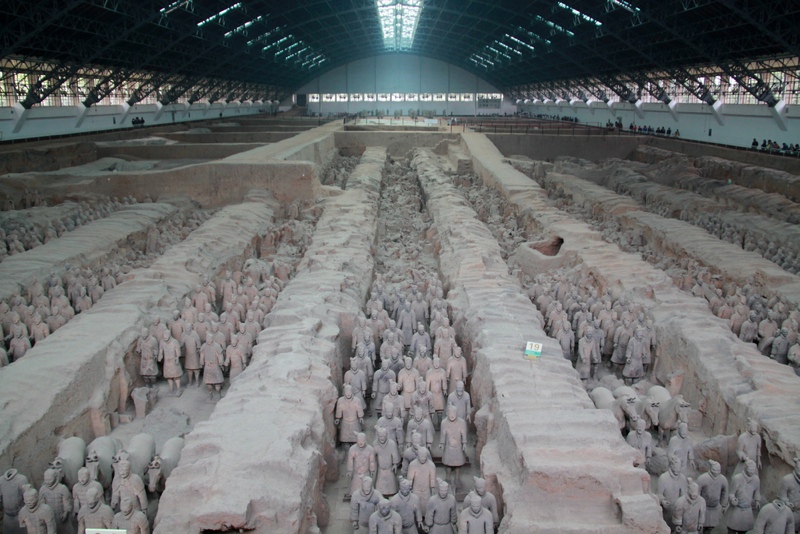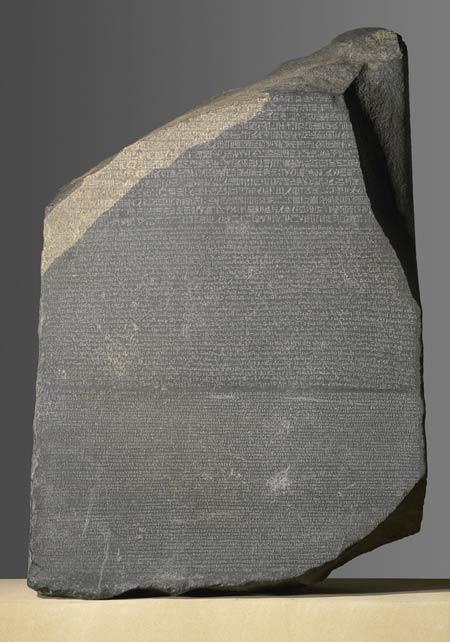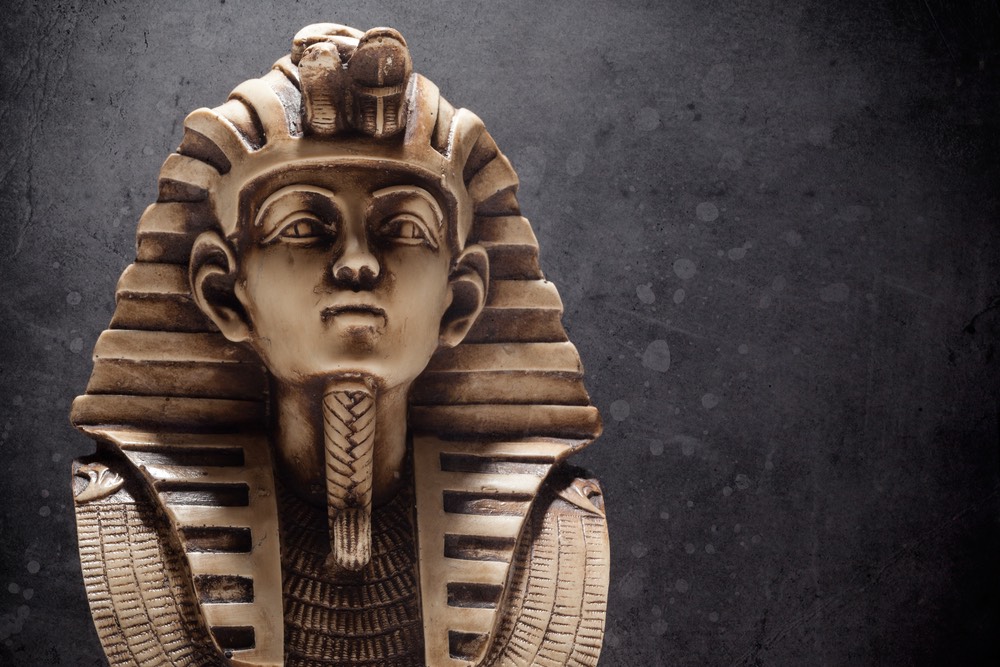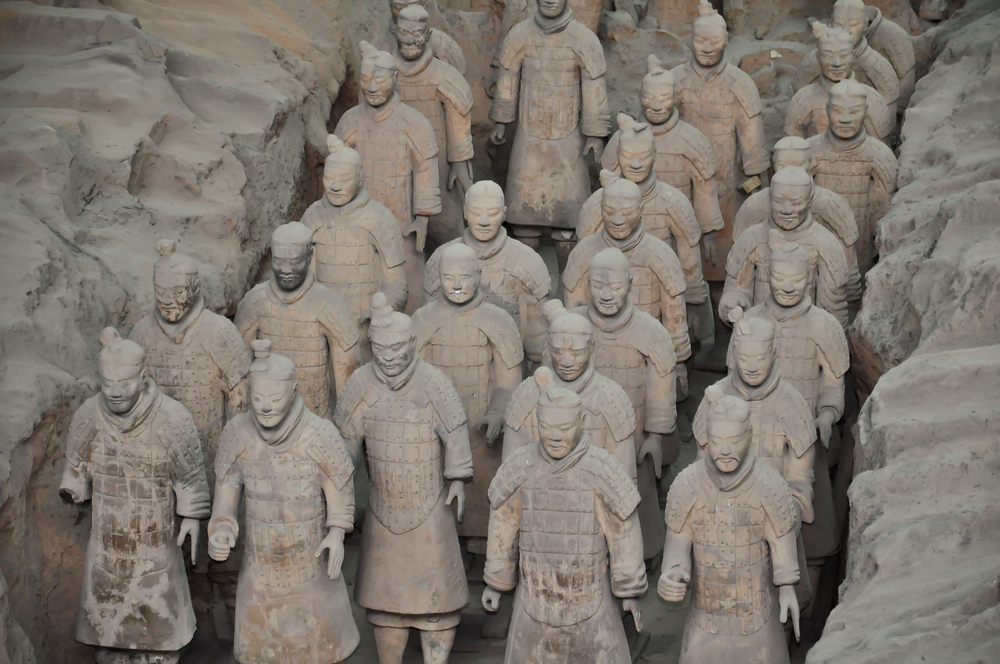Archaeological Drawing of Modern Animals Like Dinosaurs
24 Amazing Archaeological Discoveries
Amazing archaeology

Love archaeology but hate dust, dirt and human remains? You're in luck. The following list of amazing archaeological finds will take you on a trip through time and across the globe, but without all the mess (or the jetlag).
From the great, lost library of King Ashurbanipal to the toxic tomb guarded by the terracotta warriors of Shaanxi, here are the 24 most incredible archaeological findings of all time.
Rosetta Stone

In 1799, a group of French soldiers rebuilding a military fort in the port city of el-Rashid (or Rosetta), Egypt, accidentally uncovered what was to become one of the most famous artifacts in the world — the Rosetta Stone. The ancient slab was carved in 196 B.C. and bears a royal decree issued by priests on behalf of Ptolemy V, then ruler of the Ptolemaic Empire in Egypt.
But the stone's message isn't what makes it famous; it's how that message is written. The decree on the Rosetta stone is inscribed in three scripts: ancient Egyptian hieroglyphs, Egyptian demotic script and ancient Greek. In 1822, Egyptologist Jean-François Champollion deciphered the hieroglyphs on the stone, enabling future translations of other texts written in the ancient Egyptian language and reviving the lost history and culture of ancient Egypt.
Since 1802, the Rosetta Stone has resided at the British Museum in London.
The Library of Ashurbanipal

Bookworms, get ready to swoon. In the 1850s, archaeologists in Kuyunjik, Iraq, uncovered a treasure trove of clay tablets inscribed with text from the seventh century B.C. The ancient "books" belonged to Ashurbanipal, who ruled the ancient kingdom of Assyria from 668 B.C. to around 630 B.C. Among the more than 30,000 pieces of writing were historical texts, administrative and legal documents, medical treatises, "magical" manuscripts and literary works, including the "Epic of Gilgamesh" (shown here).
The texts have "unparalleled importance" in the study of ancient cultures of the Near East, according to the British Museum, where many pieces from the Library of Ashurbanipal are currently housed.
Troy

Few archaeological sites are as hotly debated as Troy, the ancient city where, according to Homer's "Illiad," the Trojan War between the kingdoms of Troy and Mycenaean Greece took place. Scholars disagree on whether this legendary war actually occurred and, if it did, if it took place at the site that many people now identify as the ancient city of Troy.
The city is believed to have stood on a site known as Hisarlik on the northwest coast of Turkey. The notion that this particular site was once the city of Troy is rooted in thousands of years of history and mythology. But in the early 19th century, an archaeologist named Heinrich Schliemann popularized the idea worldwide after a series of excavations at Hisarlik unearthed treasures that Schliemann claimed belonged to King Priam, the ruler of Troy at the time of the Trojan War.
While archaeologists cannot be completely certain that Hisarlik is the Troy of legend, they do know that the site was inhabited for thousands of years (from 3,000 B.C. to A.D. 500). In fact, Hisarlik was the location of at least 13 different cities, each one built upon the ruins of the city that came before it, according to archaeologists.
King Tut's Tomb

Mystery and intrigue surround the next archaeological discovery on our list — that of the tomb of Tutankhamun, or King Tut. The Egyptian pharaoh's lavish burial chamber was discovered in 1922 by a team of archaeologists led by British Egyptologist Howard Carter.
Tutankhamun came to power around 1332 B.C. at age 9 and died about nine years later. His unexpected death may explain why the boy pharaoh's tomb appears to have been completed in a hurry. Microbes found on the wall of the tomb suggest that the paint on the walls wasn't even dry when the tomb was sealed, archaeologists say.
When Carter and his team entered King Tut's tomb for the first time, they were confronted with a variety of treasures, including two "ebony-black" effigies of the king and an array of gold-covered couches carved into the shapes of exotic animals. The treasures of the tomb were so incredible that Carter and his team helped protect them from grave robbers by perpetuating a myth that anyone who entered the tomb would suffer under the dead pharaoh's curse. But this alleged curse hasn't stopped archaeologists from continuing to explore the famous burial chamber nearly 100 years later.
Machu Picchu

One of the most popular archaeological sites on Earth, Machu Picchu is a 15th-century Inca site seated high on a mountainside in Peru. The late Hiram Bingham III, a professor at Yale University, rediscovered the site in 1911. Until then, the ancient ruins had gone under the radar of Spanish conquistadors and settlers, leaving them remarkably well preserved.
Many archaeologists believe that Machu Picchu was once the royal estate of Pachacuti Inca Yupanqui, a 14th-century Inca ruler. The large complex covers an area of about 126 square miles (326 square kilometers) and includes walls, terraces, houses and several temples.
Pompeii

In A.D. 79, an erupting Mount Vesuvius enveloped the Roman city of Pompeii in a cloud of volcanic gases and debris, killing any of the city's residents who did not manage to flee. The remains of the city and its citizens were buried under a layer of pumice stone and ash some 19 to 23 feet (6 to 7 meters) deep, according to Encylopædia Britannica.
Pompeii remained undisturbed for over a thousand years until, in the late 16th century, an architect named Domenico Fontana stumbled upon the ancient fresco-covered walls of a Pompeii residence while working on an infrastructure project. However, no further excavations were made at the site until the mid-18th century, when workmen digging a foundation for the summer palace of the King of Naples unearthed the remains of Herculaneum (a nearby town that had suffered the same fate as Pompeii). Pompeii itself was intentionally excavated not long thereafter. Centuries later, the city continues to be a popular attraction for tourists, and many artifacts from the site can be viewed at the Naples National Archaeological Museum.

A young shepherd named Muhammed Edh-Dhib discovered the Dead Sea Scrolls by accident in the 1940s while looking for a stray goat near the ancient site of Khirbet Qumran. Located in the West Bank, near the Dead Sea, the first settlement at Qumran dates back about 2,600 years, but archaeologists believe the scrolls were penned between 250 B.C. and A.D. 68, according to the Biblical Archaeology Society, long after that first settlement had given way to a second settlement. [See Photos of Dead Sea Scrolls]
There were seven scrolls initially found by the shepherd inside of a ceramic jar in a cave near Qumran. Later, researchers and public officials discovered more than 900 other manuscripts in 11 caves in the surrounding area, according to the Israel Antiquities Authority. These scrolls include copies of Genesis, Exodus, Isaiah, Kings and Deuteronomy, as well as hymns, calendars and psalms. Some of the works represent the earliest known copies of parts of the Hebrew Bible. Many of the original copies are kept in Jerusalem, with several scrolls on public display at The Shrine of the Book, a wing of the Israel Museum.
Akrotiri, Thera

Pompeii is not the only ancient city to have been buried (and preserved) under a layer of ash and stone: The site of Akrotiri on the Greek island of Thera (now called Santorini) suffered a similar fate around 1500 B.C. The Bronze Age settlement was at the height of its development when an extremely powerful eruption of the Thera volcano covered all traces of the thriving metropolis in several meters of volcanic debris.
Some small-scale digging at Akrotiri first began in 1867, after locals discovered ancient artifacts at a quarry near the buried settlement. But a full excavation of the city wasn't carried out until 1967 under the direction of Greek archaeologist Spyridon Marinatos. He and his team uncovered a large and wealthy settlement, replete with private homes, paved streets, indoor toilets and richly painted frescoes.
But there was one thing missing from the buried city — people. Marinatos and his team did not discover any human remains at Akrotiri, leading them to believe that residents likely had some warning of the deadly eruption that ultimately wiped out their city, according to the Canadian Museum of History.
There are those who believe that the ancient myth of the sunken city of Atlantis stems from the "lost" city of Akrotiri. Unlike Atlantis, however, you can visit Akrotiri in person and view artifacts from the site at the Museum of Prehistoric Thera in Fira, on the island of Santorini in Greece.
Olduvai Gorge

One of the most important archaeological sites in the world isn't a lost city or a treasure-filled tomb — it's a steep ravine in the Great Rift Valley in Tanzania. Known as Olduvai Gorge, the site holds the earliest evidence of the existence of human ancestors.
In the 1930s, a husband and wife team of paleoanthropologists (Louis and Mary Leakey) unearthed stone tools in Olduvai Gorge, as well as skull remains belonging to a 25-million-year-old Pronconsul primate. Then in 1959, Mary Leakey uncovered parts of a skull and upper teeth belonging to Paranthropus boisei, an early human ancestor, or hominin, which lived about 1.75 million years ago. At the time, P. boisei was the oldest hominin ever discovered. The Leakeys and their two sons also went on to discover another human ancestor, Homo habilis, in Olduvai Gorge.
In 1968, Peter Nzube discovered a 1.8-million-year-old Homo habilis skull at the site. And in 1986, a team of archaeologists from Tanzania and the United States unearthed hundreds of bones belonging to a H. Habilis female who also lived some 1.8 million years ago. These and other findings at Olduvai Gorge helped to confirm that the first humans evolved in Africa.
Terracotta Warriors

In 1974, Chinese farmers unearthed one of the biggest archaeological finds of the 20th century — the terracotta army of China's first emperor, Qin Shi Huang (259 B.C. – 210 B.C.). The clay warriors, as well as their chariots and horses, were painstakingly carved and then buried near the emperor's tomb to defend him in the afterlife. Other terracotta figures, including acrobats and musicians, were also buried with the late ruler.
Located underground near the city of Xi'an in China's Shaanxi province, this huge collection of ancient figures is situated less than a mile from the pyramid-shaped mausoleum of the first emperor. But the emperor's final resting place has never been excavated. [Photos: Terracotta Warriors Protect Secret Tomb]
Archaeologists think that the opulent tomb is huge — a 38-square-mile (98 square kilometers) replica of the city of Xi'an, complete with a network of waterways and topographic features, like mountains and hills. Scientists have used remote sensing and radar devices to learn more about this underground metropolis but have yet to enter the tomb because of health concerns. Descriptions of the tomb written a century after the emperor's rule suggest that the faux rivers and streams inside the tomb once flowed with toxic mercury, and the abnormally high mercury content of the soil near the tomb lends credence to these ancient accounts.
Current page: Page 1
Next Page Page 2
Archaeological Drawing of Modern Animals Like Dinosaurs
Source: https://www.livescience.com/57690-amazing-archaeological-discoveries.html
0 Response to "Archaeological Drawing of Modern Animals Like Dinosaurs"
Post a Comment